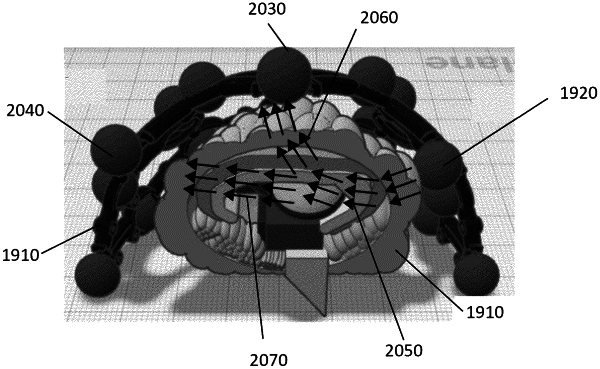| CPC A61N 1/3727 (2013.01) [A61N 1/3606 (2013.01); A61N 1/36139 (2013.01)] | 6 Claims |

|
1. A device comprising:
a plurality of stimulating and EEG sensing electrode-contacts configured to be placed around a region of interest of biological tissue, the stimulating electrode contacts selected from the group consisting of non-invasive, minimally invasive, and invasive and configured such that each electrode-contact generates a plurality of voltage-gradient geometries through the region of interest including a neural tract to at least a subset of other electrode-contacts;
a voltage-gradient geometry is selected from the group consisting of disparate, and local; and
where a voltage-gradient curvature is selected from the group consisting of positive, zero, negative, and hybrid; and
the plurality of stimulating and EEG sensing electrode-contacts are reconfigurable to measure electrical and magnetic potentials in biological tissue, the EEG sensing electrode-contacts selected from the group consisting of non-invasive, minimally invasive, or invasive; and
a controller configured to selectively modulate a voltage-gradient waveform signal between sets of electrode-contacts through the region of interest to generate different orientations and shapes of voltage-gradient geometries between the electrode-contacts by
modulating an analog or digital waveform signal using modulation selected from the group consisting of pulse-amplitude, pulse-width, pulse-frequency, and pulse-position based on;
regression models analyzing one or more dependent variables and one or more independent variables to optimize the voltage-gradient geometry on which models are selected from the group consisting of linear regression, multiple regression, multiple target regression, empirically driven Bayesian optimization, theoretically driven Bayesian optimization, and hybrid driven Bayesian optimization;
the dependent variables are selected from the group consisting of the independent dimensions of the cathode and anode electrode-contacts that are activated, the location on the plurality of electrode-contacts placed around a region of interest, the number of terminal points the voltage gradient has, the volume of the voltage gradient, the curvature of the voltage gradient, the unit charge per area of individual segments of the voltage gradient, the total charge of the total voltage gradient, the arc-length of the gradient, and the arc-path of the voltage gradient;
the independent variables are generated from the group consisting of sensor devices, biomarkers, physiologic processes, healthcare workers, clinical instruments, and clinical outcomes;
wherein the modulation of the voltage-gradient waveform signal is purposed to induce a specific physiological response in biological tissue;
where each stimulating electrode-contact has sub-electrode-contacts and each sub-electrode-contact operate in a sub-electrode-contact group;
where each sub-electrode-contacts group operates with another sub-electrode-contact group in a sub-electrode-contact super-group (SESG);
where a SESG contains 1 to (n−1) sub-electrode-contact groups where n=# of sub-electrode-contact groups where each SESG can be combined in a sub-electrode-contact super-group network (SESGN) and the algorithm to determine the number of different SESG combinations of size n is: a(n)=3∧(n−1)−2*2∧(n−1);
wherein electrode-contacts and sub-electrode-contacts are made from flexible circuits and conductive materials selected from, but not limited to, the group consisting of silver chloride, silver, gold, and stainless steel to account for different head topologies.
|